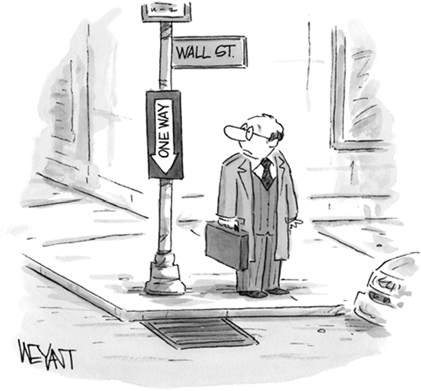“The speculator’s primary interest lies in anticipating and profiting from market fluctuations. The investor’s primary interest lies in acquiring and holding suitable securities at suitable prices.”
— Benjamin Graham
While we seldom like to make specific market comments, the recent deterioration in stock prices merits a brief observation. At mid‐year, the SP500 Index was 75 months from the beginning of its current bull cycle in March 2009 and market participants have begun to wonder if the current environment is indicating the end of a cycle, or just a brief pause before beginning the next leg up.
In the first half of the year the Canadian stock market seemed to have two lanes. High‐quality stocks with good growth prospects sped forward in the fast, while stocks with reasonable valuations but GDP‐type growth crept along in the slow lane. And stocks with any exposure to oil and gas were stalled at the roadside.

In July, the two‐lane market slowed down. High‐quality stocks have sold off and many now trade at more attractive multiples than a few months ago. A sub‐$50 oil price and the sudden China stock market reversal were the proximate causes of the selloff; antsy market participants are anxiously awaiting the Federal Reserve’s initiation of its normalization process via hiking the Fed funds rate.
While our fund does not own any metals & mining stocks for reasons discussed in previous comments, the simultaneous collapse in the prices of hard and soft commodities has been striking and flashes a red signal on global growth. Commodity prices tend to be negatively correlated with USD, which has been strong against most global currencies. Many of the companies in our fund manufacture in Canada and export some production, but we have not yet heard any management teams tout the low CAD as a tailwind. Weak demand and anaemic growth are the bigger focus.
At Laurus, our practice is not to attempt to call the bottom on specific assets or the market as a whole. Paraphrasing Howard Marks, we view the future as not a fixed outcome capable of being predicted, but as a range of possibilities, which we attempt to assess probabilistically. Despite the unappealing short‐term picture (our accompanying tongue‐in‐cheek New Yorker cartoon notwithstanding), in most scenarios we can envision unfolding, companies with solid balance sheets, high returns on invested capital, proven management teams, and sustainable competitive advantages will accrete value and generate good returns for shareholders over the next 3 to 5 years. So, while we keep checking for signposts of how the Canadian and global economy will do over the next 12‐18 months, we are pleased to pay cheaper prices for high‐quality stocks whose long‐term outlook has not materially deteriorated.
When we visited the CEOs and CFOs of some of our Calgary‐ headquartered portfolio holdings in June, their tone was cautious and circumspect. We only own one E&P company so our oilpatch exposure is principally through service companies. These managers are coping with lower oil prices by reducing staff, restructuring operations to take out costs, cutting capex budgets, and allocating capital to regions or services that will benefit early in the recovery cycle, such as LNG.
Because we own companies with healthy balance sheets, none face existential risk even if the oil price remains low. Constrained competitors may downsize or exit, clearing the competitive landscape for survivors. Having a debt‐burdened balance sheet versus having modest, manageable debt is like climbing a hill with a 50‐pound pack versus a 10‐pound pack. While it may be easy to carry at the beginning of the trip, it gets tougher as the incline continues to steepen and the sun beats down. Those with the least to haul are likeliest to ascend to the summit.
